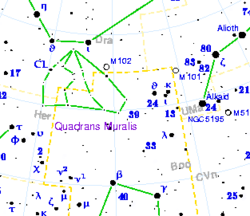Top Qs
Timeline
Chat
Perspective
CL Draconis
Star in the constellation Draco From Wikipedia, the free encyclopedia
Remove ads
CL Draconis is a single[10] star in the northern circumpolar constellation of Draco. It can be viewed with the naked eye, having an apparent visual magnitude of 4.96.[2] The distance to this star, as determined from its annual parallax shift of 29.9 mas,[1] is 109 light years. It is moving closer to the Earth with a heliocentric radial velocity of −11 km/s.[5] The star has a relatively high proper motion, traversing the celestial sphere at the rate of 0.185″/yr.[11]
Based upon a stellar classification of F0 IV,[3] this is an aging F-type subgiant star that has consumed the hydrogen at its core. It is spinning rapidly with a projected rotational velocity of 165 km/s,[6] giving it an oblate shape with an equatorial bulge that is estimated to be 8% larger than the polar radius.[12]

CL Draconis is a Delta Scuti variable, changing brightness with an amplitude of 0.010 magnitude over a period of 1.83 hours.[14] CL Dra has 1.68[6] times the mass of the Sun and is radiating 10.2[6] times the Sun's luminosity from its photosphere at an effective temperature of 7,439 K.[7]
It was transferred from Draco to Quadrans Muralis. Later when the International Astronomical Union officially recognised constellations, Quadrans Muralis became obsolete, so this star was moved back to Draco.
Remove ads
References
Wikiwand - on
Seamless Wikipedia browsing. On steroids.
Remove ads

